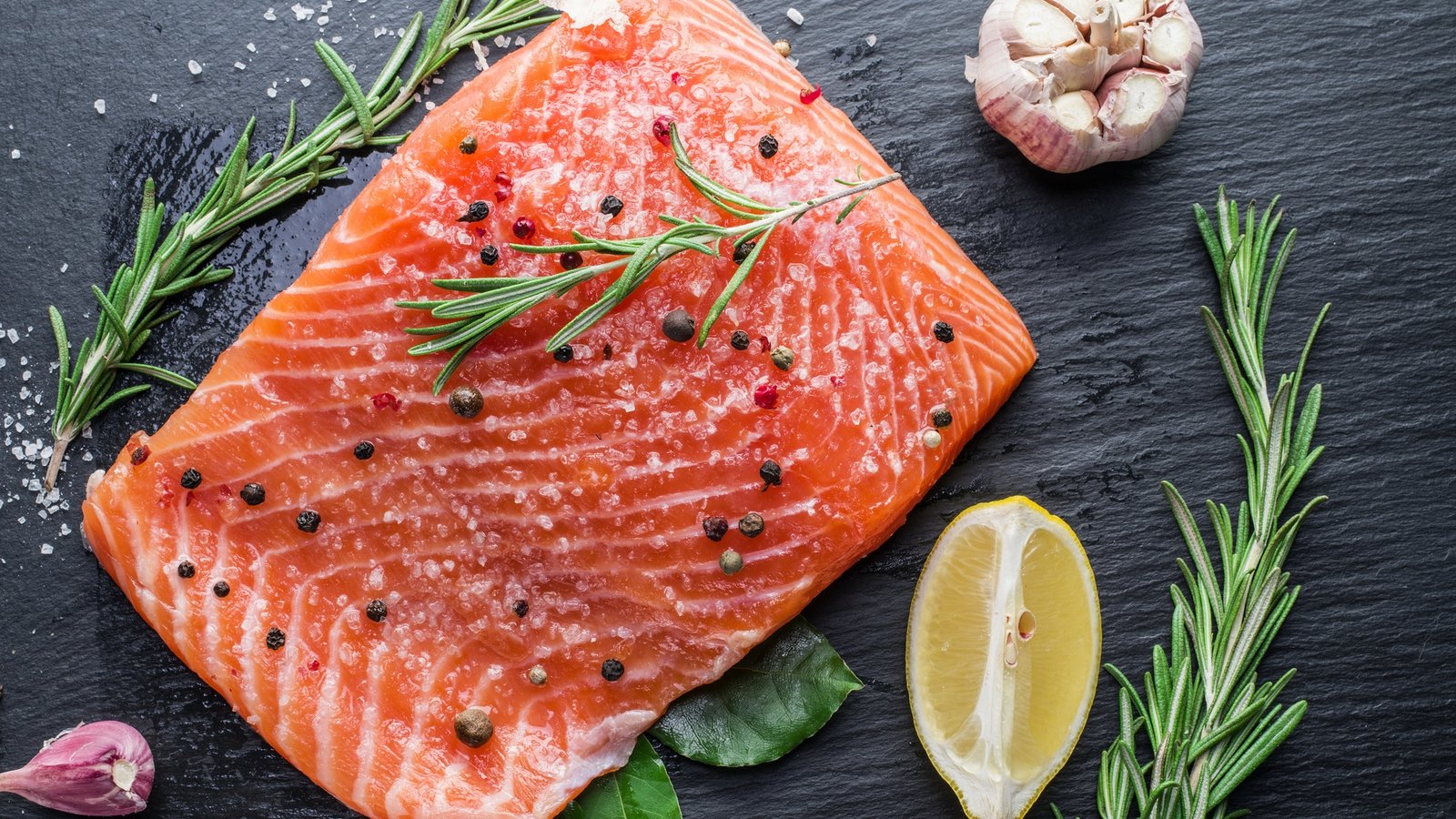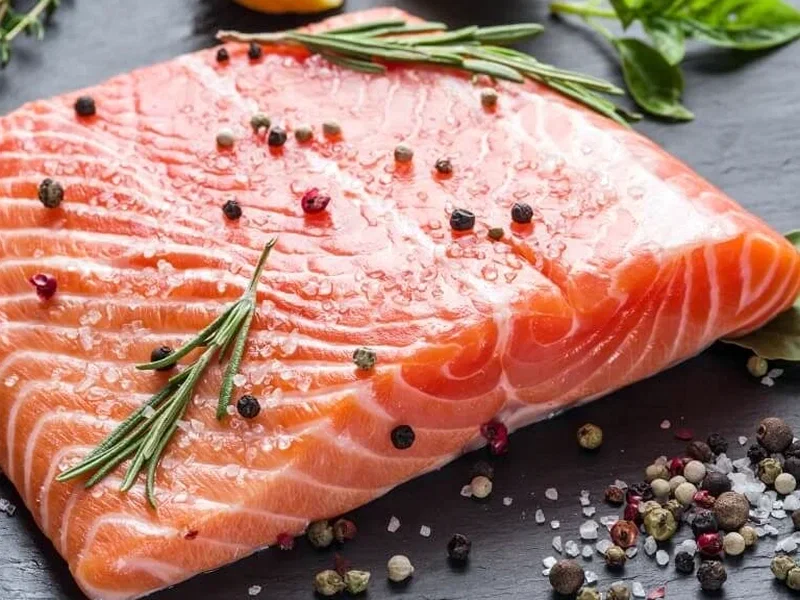Salmon: Top 11 Health Benefits and How to Enjoy It
Salmon is more than just a delicious fish — it’s a powerhouse of nutrients that supports muscle growth, heart health, glowing skin, and even boosts your mood. Thanks to its rich content of omega-3, 6, and 9 fatty acids, protein, astaxanthin, and selenium, salmon offers both antioxidant and anti-inflammatory benefits.

Why Salmon Is So Good for You
Let’s dive into some of the main health benefits of adding salmon to your weekly meals:
1. Builds and Maintains Muscle
Packed with high-quality protein, salmon helps repair and grow muscle tissue — perfect for those looking to maintain strength or gain lean mass. Combine it with a balanced diet and regular exercise for best results.
2. Protects Your Heart
The omega-3, 6, and 9 fats in salmon help reduce bad cholesterol (LDL) and increase good cholesterol (HDL), preventing the buildup of plaque in your arteries. This lowers the risk of heart conditions like stroke and heart attack.
3. Supports Skin Health
Thanks to astaxanthin — a powerful antioxidant — salmon helps protect the skin from sun damage, preventing wrinkles and sagging. Omega fats also keep your skin hydrated, soft, and elastic by strengthening its natural barrier.

4. Fights Inflammation
Omega-3s in salmon reduce inflammatory markers in the body, which can help manage conditions like rheumatoid arthritis and inflammatory bowel disease.
5. Boosts Immunity
Salmon is rich in selenium and B vitamins, which support the immune system by enhancing the function of white blood cells.
6. Promotes Brain Health
With a high concentration of omega-3s and vitamin B12, salmon plays a role in protecting the brain. It may help reduce the risk of neurodegenerative diseases like Alzheimer’s, Parkinson’s, and multiple sclerosis, while also improving memory and cognitive function.
7. Supports Thyroid Function
Selenium, found abundantly in salmon, is essential for converting thyroid hormones to their active form — keeping your metabolism and energy levels stable.
8. Improves Mood
Salmon is a natural mood-booster thanks to vitamin B6 and tryptophan, which help produce serotonin, a neurotransmitter that regulates sleep, appetite, and emotional well-being.
9. May Lower Cancer Risk
The antioxidants and healthy fats in salmon help protect cells from DNA damage, potentially lowering the risk of several types of cancer, including breast, prostate, colon, and lung cancers.
10. Strengthens Bones
Salmon is a great source of vitamin D, which aids in calcium and phosphorus absorption — essential for keeping bones strong and preventing osteoporosis.
11. Protects Eye Health
Astaxanthin helps maintain blood flow to the retina and shields eye cells from UV damage, which can prevent vision problems like glaucoma and eye strain.

Types of Salmon
There are two main types of salmon:
-
Wild (Pacific Salmon): Higher in protein and lower in saturated fat and calories.
-
Farmed (Atlantic Salmon): Contains more omega-3s but also has more saturated fat and may carry residues from antibiotics or PCBs (chemical compounds linked to certain health risks).
Nutrition Facts (per 100g of cooked salmon)
| Nutrient | Wild Salmon | Farmed Salmon |
|---|---|---|
| Calories | 182 kcal | 206 kcal |
| Protein | 25.4 g | 22.1 g |
| Total Fat | 8.1 g | 12.4 g |
| Saturated Fat | 1.3 g | 2.4 g |
| Omega-3 | 2.31 g | 2.50 g |
| Vitamin D | 11 mcg | 11 mcg |
| Selenium | 46.8 mcg | 41.4 mcg |
| Vitamin B12 | 3.05 mcg | 2.8 mcg |
How to Eat Salmon
Salmon is incredibly versatile! You can enjoy it raw in ceviche, sashimi, tartare, or carpaccio — or cook it grilled, baked, or pan-seared with herbs and spices. For maximum health benefits, aim for two to three 85-gram servings per week.
Healthy Salmon Recipes
Here are three easy and nutritious ways to prepare salmon:
1. Grilled Salmon
Ingredients:
-
1 salmon steak
-
Salt and pepper to taste
-
1 tsp olive oil
Instructions:
Season the salmon and let it rest in the fridge for 1 hour. Heat a non-stick skillet, add oil, and cook the salmon for 4 minutes on each side. Serve with rice, couscous, or vegetables.
2. Salmon Sashimi
Ingredients:
-
500g salmon loin
-
Zest of 1 lemon
-
Sesame seeds (optional)
-
Soy sauce (optional)
Instructions:
Slice the salmon into 10g pieces. Arrange on a plate, top with lemon zest, and serve with soy sauce and sesame seeds if desired.
3. Salmon Tartare
Ingredients:
-
200g skinless salmon
-
½ red onion, finely chopped
-
1 tbsp Dijon mustard
-
½ tbsp homemade mayo
-
Salt to taste
-
Toasts for serving
Instructions:
Chop the salmon into fine cubes. Mix with onion, mustard, and mayo until smooth. Season and serve on toast.
Common Questions
Is salmon an inflammatory food?
No — it’s actually anti-inflammatory due to its healthy fats and antioxidants.
Can pregnant women eat raw salmon?
No — raw salmon may carry bacteria or parasites. Pregnant women, children, the elderly, and immunocompromised individuals should avoid raw fish.




